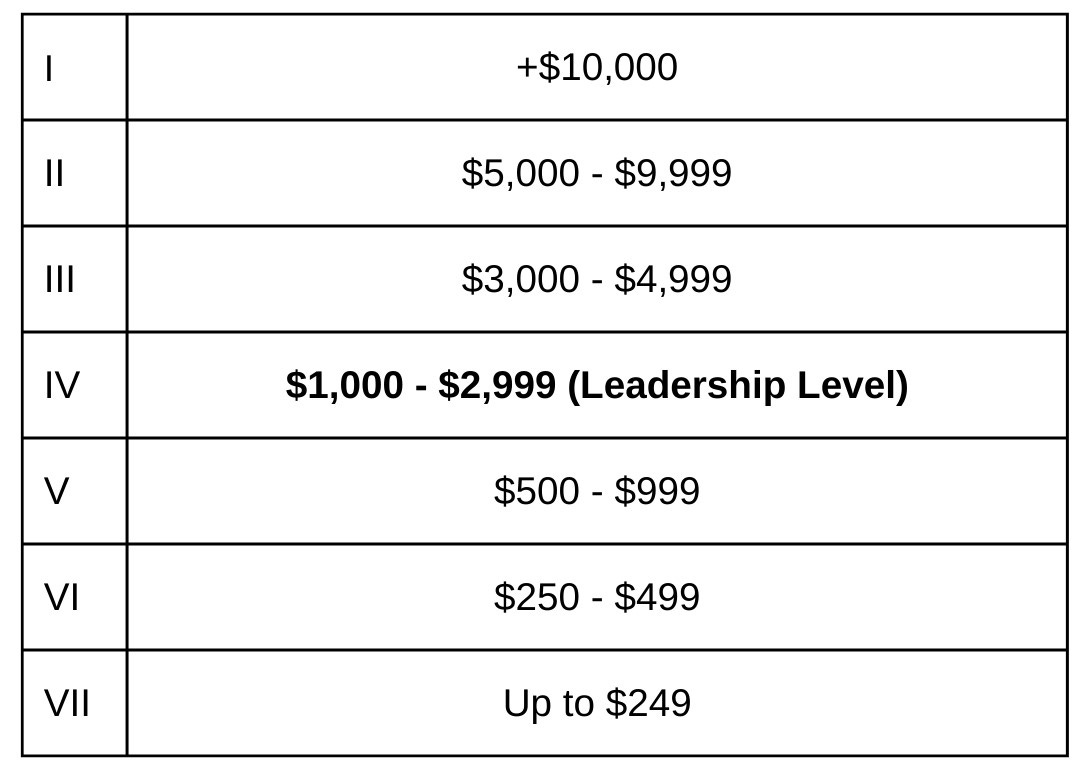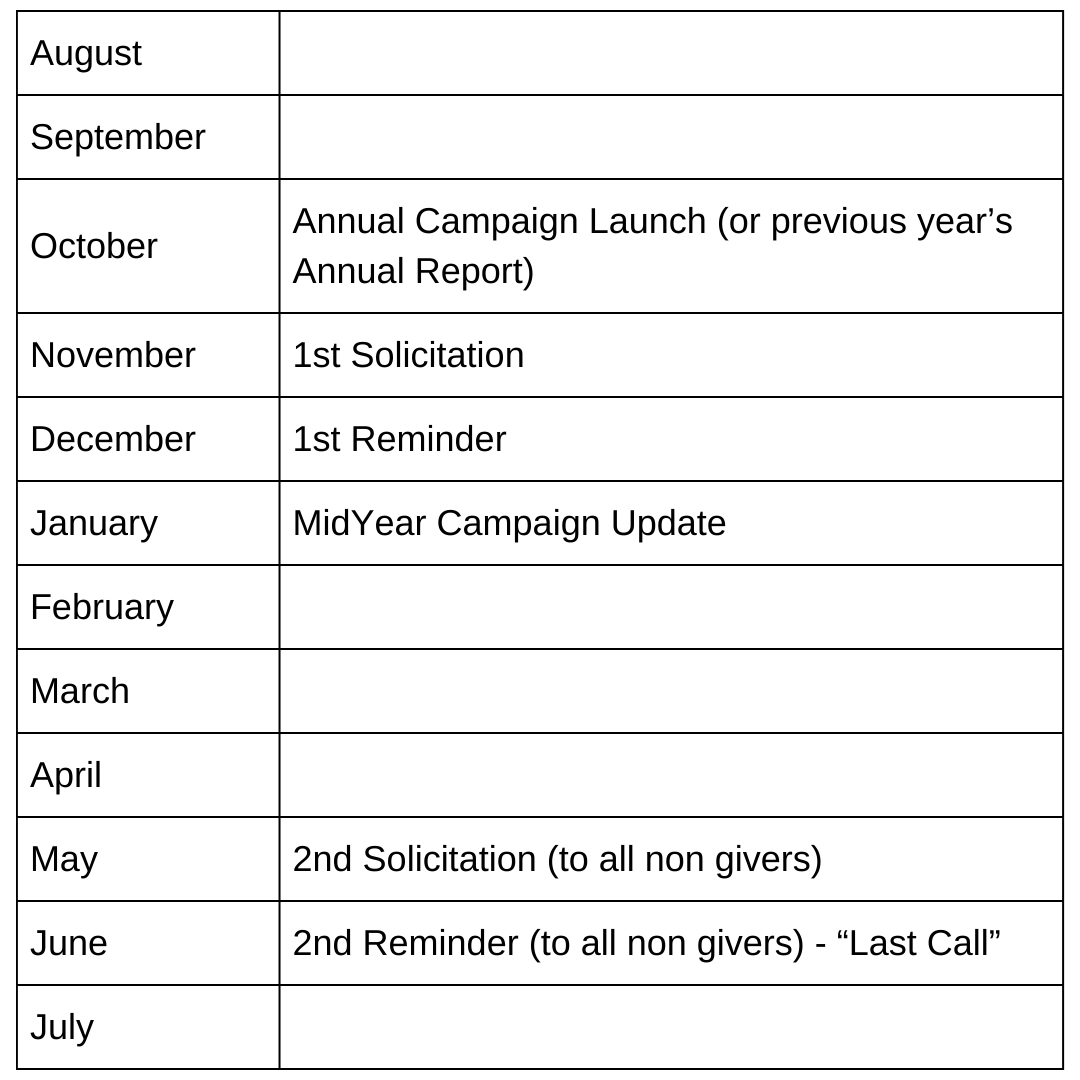The Elements of an Annual Fund
An annual fund forms the basis for dependable school support. While there are many ways schools can raise money, such as through fundraising events and capital campaigns, the most dependable way is through the annual solicitation of gifts.
This article outlines the elements of an annual fund and suggests some very practical things you can do to ensure a successful campaign. Feel welcome to read the article in its entirety, or to use the list below as a table of contents to skip ahead to a particular section.
What is an Annual Fund?
Setting Goals
Giving Tiers
Mailing Schedule
Donor Meetings
Thank Yous
Planning Ahead
What is an Annual Fund?
An annual fund, as the name suggests, is an annual appeal for gifts to support the ongoing needs of an organization, in this example a school. An annual fund is not an “above and beyond” campaign for big ticket items, such as buildings and equipment, but a fund to satisfy already budgeted needs of the current fiscal year. In other words, without an annual fund there would exist a budget shortfall.
The purpose of this model is to enrich school offerings as much as possible while raising the price of tuition as little as possible from year to year, relying on voluntary community support to equitably bridge the gap between the price of tuition and the full cost of educating each student.
Setting Goals
The gap covered by an annual fund varies, but $1,000 to $3,000 per student is not uncommon. For the sake of example, let’s say the funding gap at our K-8 parochial school is $1,000 per student and we have 200 students enrolled. In this case, our ideal annual fundraising goal is $200,000/year.
Now, depending on whether your annual fund is new or established this goal may or may not be realistic and you might still rely on other means of funding to close the gap. This is fine. Over time, however, it is of greater benefit to direct fundraising efforts to the annual fund. Soliciting money via events not only requires more effort and stress on the part of the organization but it also diminishes to some degree the individual’s sense of obligation. Donors would be better served supporting your school because they love its mission than because they receive a ski vacation as a bonus.
Of course, you can’t expect to bridge this gap overnight. The aim should be to identify a sustainable level of giving from your community and to increase the goal over time as graduating students, parents, grandparents, businesses, and foundations see the result of your work and happily continue their support. (A growth rate of 5-10% is excellent.) A strong annual fund will eventually outperform fundraising events, pave the way for capital campaigns, and promote a healthy culture of giving.
So let’s set an annual fund goal of $100,000.
With a campaign goal of $100,000, we can reasonably expect that 80% of this amount will come from just 20% of families. This is the 80/20 rule.
If our school has 200 students, it likely has somewhere north of 100 families, given siblings. For our purposes, let’s pencil in 140 families. So we might expect roughly $80,000 from 30 families, with the remaining $20,000 coming from the remaining 110 families.
This should help to focus efforts.
Giving Tiers
Giving tiers establish visible campaign goals. This is helpful both for use in fundraising communications and in the fundraiser’s work of categorizing donors. From the donor’s perspective, tiers allow them to see where need exists and the level at which they can see themselves giving. Fundraisers can use them to identify the kinds of gifts that are needed to ensure a successful campaign.
Below is an outline of possible giving tiers for a $100,000 campaign. Be sure to include a “Leadership” giving level that will capture at least 80% of total need. In our example, the annual funding gap is $1,000 per student, so the Leadership giving tier could mean any gift +$1,000, assuming that 80% of the goal will come from gifts above this point.
There should be enough giving tiers so that everyone in the community is able to participate in a meaningful way while reserving special recognition for those who display an exceptional capacity for support. Of course, the more names the better! Everyone is excited when long lists of names fill the acknowledgement pages.
Participation from current parents should always aim at 100%, of course, but anything between 75% to 85% is not an immediate cause for concern. Though the trend should be up. The community should understand that everyone’s help is required to meet the need. The only gift too small is no gift at all!
Mailing Schedule
The school’s fiscal year may not align with the calendar year, but most donors will make their gift on one of two dates: December 31 (for tax reasons) or the final day of the fiscal year (because life is hectic). In any case, most schools set their fiscal year in line with the school year, or July 1 to June 30, meaning December 31 and June 30 are the two best dates for receiving gifts.
With this in mind, plan to send at least six fundraising focused mailings per year.
In the first half of the year, this includes a campaign launch letter, a first solicitation letter, and a solicitation reminder. After the new year begins, plan to send a midyear campaign update, a second solicitation letter to those who have not yet given, and a second solicitation reminder, or “last call,” to those still holding out.
Here is a sample mailing schedule:
Keep in mind, organizing the fundraising mailing schedule in a school is a delicate balance, since it must align with myriad school communications, such as letters from the head of school, school supplies lists, field trip announcements, tuition payment reminders, and many, many, more! There never seems to be a shortage of vital school communications.
However, fundraising does not exist in a vacuum but inline with all other school activities. Try to align development mailings in a way that complements other school communications while still highlighting their special importance. For example, waiting to launch the campaign until October provides a brief warm-up period for parents to adjust to the start of the new year.
Of course, all school communications are essentially development communications since they each in some way convey mission by reflecting the tone and spirit of the school.
For fundraising, paper communications are best. Digital communications have their place, but they are not as effective at emphasizing stability and tone like a hard piece of mail sent at just the right time. Reserve the email blasts for December and June. Experiment with various types of mail, letters in envelopes vs postcards, for example. And don’t forget to fill your pieces with high quality photos teeming with lots of happy, attractive, people. People, not things! Pictures of people keep the community top of mind.
Pro tip: take the extra time to hand place stamps on your bulk mailings. This touch will signal your attention to detail.
Donor Meetings
It is not lost on this writer that you likely wear multiple hats, as a teacher, a coach, a bus driver, AND a fundraiser. If so, you’re not alone! And this can be a great advantage.
While the head of school will normally be the best spokesman for institutional need, you are the one tasked with running the campaign. For this it’s essential to be known in the community for what you do. You = fundraising guy.
Go to school events, walk the hallways, check out a baseball game, hang out with the faculty. Though you should do these things anyway because they’re fun, they’re also the easiest way to experience the life of school and to strike up a conversation with a member of the community. (BTW, if your events are not fun, you can change this!) Your knowledge of daily events will lend itself well to sharing the school’s mission and asking for support.
Within the mailing calendar try to meet with 40 people, formally or informally, to share the work of the annual fund and/or to ask for their support. Recall the 80/20 rule?
While these 40 conversations should reflect the needs of the school, not all need to include an ask for money. In fact, they shouldn’t! Asking open questions such as, why did you choose this school and not that other school for your child can provide a wealth of information about a person’s inclination for support and why that choice was important for them. Establishing common ground such as this is the basis of relationship building.
For those who have a greater capacity for support you should consider a predetermined ask amount in your conversation, and top donors should be given a personal ask. Originating these asks from a casual first meeting at Back to School night is a natural and easy way to do this. The rule of thumb is that it requires around six touches with a donor before they give.
A fundraiser is a special kind of friend. You are not a donor’s best friend, or the person they necessarily call when they want to see a movie, but the person they can trust to link their charitable giving with the organization they care about. This is a very special role and one which can truly shape a donor’s life story.
On this point, fundraising legend Jerry Panas offers one of my favorite fundraising jokes.
Q. What does it take to be a great fundraiser?
A. Honesty and integrity. So if you can fake these two things, you’ve got it made!
Thank Yous
Acknowledging a gift is the first step in soliciting a new gift.
Gift stewardship is perhaps the process that varies most based on the size and sophistication of a fundraising shop. It is also the easiest component to improve and the most tragic to overlook.
Gifts arrive in different ways and in different forms; online via credit card, in the mail, via stock transfer, in a wadded ball of cash. Toss in crypto, real estate, precious heirlooms and this can get quite complicated. But don’t overthink gratitude. While it’s up to you to set guidelines about what you can and cannot accept as a gift, at a minimum, every gift should be acknowledged in some way by the organization.
One acknowledgement process might include:
Instant gift receipt for all gifts made online.
Formal gift receipt printed on school letterhead and snail mailed to the donor (including the gift amount, the date the gift was made, the purpose of the gift, and any necessary IRS gift language). Having the head of school include a personalized “thank you” in his own hand at the bottom is a rock star improvement to this otherwise transactional receipt.
A handwritten note from yourself saying, “Thank you for your support!”
The order of the above is not vital, but don’t neglect to send something. A text or a phone call could also do the trick. The sooner the better, but try not to let this extend beyond a month from the date of the gift. Although you will likely never hear this from them directly, over time donors will look forward to the personal contact they receive as a consequence of giving. This is good stewardship.
Of course, the last person to thank should be yourself and you can do this by making sure these gifts are well recorded in a good database. This will allow you to track your progress, record information for the sake of posterity, and be ready to prepare an annual report as a launch to the next year’s campaign.
Planning Ahead
The average tenure for a gift officer is less than 18 months. This is interesting, given the role of a fundraiser is to help create institutional stability.
If approached from a posture of “sales-lite,” fundraising can become a grind and lead to burnout. Plan to be in your role for a while. Plan to be a part of the community. Plan to become real friends with your colleagues. This will make what you do much more than work, but a joyful and mission aligned service.
Of course, another reason to stick around is that the work you do only gets more efficient every year. At some point you will no longer find yourself drinking from a fire hose of schemata, but able to concentrate on growing relationships. A seasoned fundraiser is worth his weight in gold for the institutional knowledge he possesses and the stability he can bring.
If you’re new to the work of fundraising, enjoy the chaotic early days! They will not last forever, but will become proof of progress. Fundraising is joyful work.
Connect with me on LinkedIn to continue the conversation.





